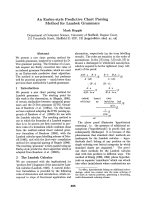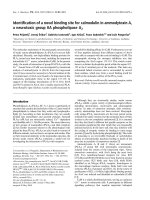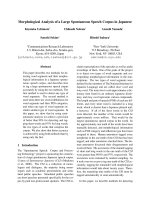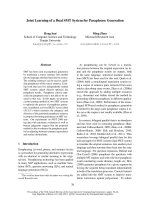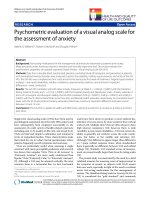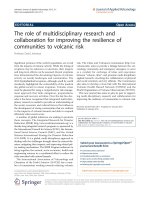Báo cáo toán học: "Further applications of a power series method for pattern avoidance" ppt
Bạn đang xem bản rút gọn của tài liệu. Xem và tải ngay bản đầy đủ của tài liệu tại đây (106.09 KB, 8 trang )
Further applications of a power series method
for pattern avoidance
Narad Rampersad
∗
Department of Mathematics and Statistics
University of Winnipeg
515 Portage Avenue
Winnipeg, Manitoba R3B 2E9 (Canada)
Submitted: Jul 31, 2009; Accepted: Jun 10, 2011; Published: Jun 21, 2011
Mathematics Subject Classification: 68R15
Abstract
In combinatorics on words, a word w over an alphabet Σ is said to avoid a pattern
p over an alphabet ∆ if there is no factor x of w and no non-erasing morphism h
from ∆
∗
to Σ
∗
such that h(p) = x. Bell and Goh have recently applied an algebraic
technique due to Golod to show that for a certain wide class of patterns p there
are exponentially many words of length n over a 4-letter alphabet that avoid p. We
consider some further consequences of their work. In particular, we show that any
pattern with k variables of length at least 4
k
is avoidable on the b inary alphabet.
This improves an earlier bound due to Cassaigne and Roth.
1 Introduction
In combinatorics on words, the notion of an avoidable/unavoidable pattern was first in-
troduced (independently) by Bean, Ehrenfeucht, and McNulty [1] and Zimin [22]. Let Σ
and ∆ be alphabets: the alphabet ∆ is the pattern alphabet and its elements are variables.
A pattern p is a non-empty word over ∆. A word w over Σ is an instance of p if there
exists a non-erasing morphism h : ∆
∗
→ Σ
∗
such that h(p) = w. A pattern p is avoidable
if there exists infinitely many words x over a finite alphabet such that no factor of x is an
instance of p. Otherwise, p is unavoidable. If p is avoided by infinitely many words on an
m-letter alphabet then it is said to be m-avoidable. The survey chapter in Lothaire [12,
Chapter 3] gives a good overview of the main results concerning avoidable patterns.
∗
The author is supported by an NSERC Postdoctoral Fellowship.
the electronic journal of combinatorics 18 (2011), #P134 1
The classical results of Thue [19, 20] established that the pattern xx is 3-avoidable
and the pattern xxx is 2-avoidable. Schmidt [17] (see also [14]) proved that any binary
pattern of length at least 13 is 2-avoidable; Roth [1 5] showed that the bound of 1 3 can
be replaced by 6. Cassaigne [7] and Vani˘cek [21] (see [10]) determined exactly the set of
binary patterns that a re 2-avoidable.
Bean, Ehrenfeucht, and McNulty [1] and Z imin [22] characterized the avoidable pat-
terns in general. Let us call a pattern p for which all variables occurring in p occur at least
twice a doubled pattern. A consequence of the characterization of the avoidable patterns is
that any doubled pattern is avoidable. Bell and Goh [3] proved the much stronger result
that every doubled pattern is 4-avoidable. Cassaigne and Roth (see [8] or [12, Chapter 3])
proved that any pattern containing k distinct variables and having length greater than
200 · 5
k
is 2-avoidable. In this note we apply the arguments of Bell a nd Goh to show the
following result, which improves that of Cassaigne and Roth.
Theorem 1. Let k be a positive integer and let p be a pattern containing k dis tinc t
variables.
(a) If p has le ngth at least 2
k
then p is 4-avoidable.
(b) If p has le ngth at least 3
k
then p is 3-avoidable.
(c) If p has le ngth at least 4
k
then p is 2-avoidable.
2 A power series approach
Rather than simply wishing to show the avoidability of a pattern p, one may wish instead
to determine the number of words of length n over an m-letter alphabet t hat avoid p (see,
for instance, Berstel’s survey [4]). Brinkhuis [6] and Brandenburg [5] showed that there
are exponentially many words of length n over a 3-letter alphabet that avoid the pattern
xx. Similarly, Brandenburg showed tha t there are expo nentially many words of length n
over a 2-letter alphabet t hat avoid the pattern xxx.
As previously mentioned, Bell and Goh proved t hat every doubled pattern is 4-
avoidable. In fact, they proved the stronger result that there are exponentially many
words of length n over a 4-letter alphabet that avoid a given doubled pattern. Their main
tool in obtaining this result is the following (here [x
n
]G(x) denotes the coefficient of x
n
in the series expansion of G(x)).
Theorem 2 (Golo d). Let S be a set of words over an m-letter alphabet, each word of
length at least 2. Suppose that for each i ≥ 2 , the set S contains at most c
i
words of length
i. If the power series expansion of
G(x) :=
1 − mx +
i≥2
c
i
x
i
−1
(1)
has non-negative coefficients, then there are least [x
n
]G(x) words of length n over an
m-letter alphabet that avoid S.
the electronic journal of combinatorics 18 (2011), #P134 2
Theorem 2 is a special case of a result originally presented by Golod (see Rowen
[16, Lemma 6.2.7 ]) in an algebraic setting. We have stated it here using combinatorial
terminology. The proof given in Rowen’s book also is phrased in algebraic terminology;
in order to make the technique perhaps a little more accessible to combinatorialists, we
present a proof of Theorem 2 using combinatorial language.
Proof of Theorem 2. For two power series f(x) =
i≥0
a
i
x
i
and g(x) =
i≥0
b
i
x
i
, we
write f ≥ g to mean that a
i
≥ b
i
for all i ≥ 0. Let F(x) :=
i≥0
a
i
x
i
, where a
i
is the
number of words of length i over an m-letter alphabet that avoid S. Let G(x) :=
i≥0
b
i
x
i
be the power series expansion of G defined above. We wish to show F ≥ G.
For k ≥ 1, there are m
k
− a
k
words w of length k over an m-letter alphabet that
contain a word in S as a factor. On the other hand, for any such w either (a) w = w
′
a,
where a is a single letter and w
′
is a word of length k − 1 containing a word in S as a
factor; or (b) w = xy, where x is a word of length k − j that avoids S and y ∈ S is a word
of length j. There are at most (m
k−1
− a
k−1
)m words w of the form (a), and there are at
most
j
a
k−j
c
j
words w of the for m (b). We thus have the inequality
m
k
− a
k
≤ (m
k−1
− a
k−1
)m +
j
a
k−j
c
j
.
Rearranging, we have
a
k
− a
k−1
m +
j
a
k−j
c
j
≥ 0, (2)
for k ≥ 1.
Consider the function
H(x) := F (x)
1 − mx +
j≥2
c
j
x
j
=
i≥0
a
i
x
i
1 − mx +
j≥2
c
j
x
j
.
Observe that for k ≥ 1, we have [x
k
]H(x) = a
k
− a
k−1
m +
j
a
k−j
c
j
. By (2), we have
[x
k
]H(x) ≥ 0 for k ≥ 1. Since [x
0
]H(x) = 1, the inequality H ≥ 1 holds, and in particular,
H − 1 has non-negative coefficients. We conclude that F = HG = (H − 1)G + G ≥ G, as
required.
Theorem 2 bears a certain resemblance to the Goulden–Jackson cluster method [11,
Section 2.8], which also produces a formula similar to (1). The cluster method yields an
exact enumeration of t he words avoiding the set S but requires S to be finite. By contrast,
Theorem 2 only gives a lower bound on the number of words avoiding S, but now the set
S can be infinite.
Theorem 2 can be viewed as a non-constructive method to show the avoidability of
patterns over an alphabet of a certain size. In this sense it is somewhat reminiscent of
the electronic journal of combinatorics 18 (2011), #P134 3
the probabilistic approach to pattern avoidance using the Lov´asz local lemma (see [2, 9]).
For pattern avoidance it may even be more powerful than the local lemma in certain
respects. For instance, Pegden [13] proved that do ubled patterns are 22-avoidable using
the local lemma, whereas Bell and Goh were able to show 4- avoidability using Theorem 2.
Similarly, the reader may find it a pleasant exercise to show using Theorem 2 that there
are infinitely many words avoiding xx over a 7-letter alphabet; as far as we are aware,
the smallest alphabet size for which the avoidability of xx has been shown using the local
lemma is 13 [18].
3 Proof of Theorem 1
To prove Theorem 1 we begin with some lemmas.
Lemma 3. Let k ≥ 1 and m ≥ 2 be integers. If w is a word of length at least m
k
over a k-letter alphabet, then w contains a non-empty factor w
′
such that the number of
occurrences of each letter in w
′
is a multiple of m.
Proof. Suppose w is over the alphabet Σ = {1 , 2 , . . . , k}. Define the map ψ : Σ
∗
→ N
k
that maps a word x to the k-tuple [|x|
1
mod m, . . . , |x|
k
mod m], where |x|
a
denotes the
number of occurrences of the letter a in x. For each prefix w
i
of length i of w, let
v
i
= ψ(w
i
). Since w has length at least m
k
, w has at least m
k
+ 1 prefixes, but there are
at most m
k
distinct tuples v
i
. There exists therefore i < j such that v
i
= v
j
. However,
if w
′
is the suffix of w
j
of length j − i, then ψ(w
′
) = v
j
− v
i
= [0, . . . , 0], and hence the
number of occurrences of each letter in w
′
is a multiple of m.
Lemma 4 ([3]). Let k ≥ 1 be an integer and let p be a pattern over the pattern alphabet
{x
1
, . . . , x
k
}. Suppose that for 1 ≤ i ≤ k, the variable x
i
occurs a
i
≥ 1 time s in p. Let
m ≥ 2 be an integer and let Σ be an m-letter alphabet. Then for n ≥ 1, the number of
words of length n over Σ that are in stances of the pattern p is at mo s t [x
n
]C(x), whe re
C(x) :=
i
1
≥1
· · ·
i
k
≥1
m
i
1
+···+i
k
x
a
1
i
1
+···+a
k
i
k
.
For the proof of the next result, we essentially follow the approach of Bell and Goh.
Theorem 5. Let k ≥ 2 be an integ er and let p be a pattern over a k-letter pattern alphabet
such that every variable occurring in p occurs a t least µ times.
(a) If µ = 3, then for n ≥ 0, there are at least 2.94
n
words of length n avoiding p over
a 3-l etter alphabet.
(b) If µ = 4 , then for n ≥ 0, there are at least 1.94
n
words of length n avoiding p over
a 2-l etter alphabet.
the electronic journal of combinatorics 18 (2011), #P134 4
Proof. Let (m, µ) ∈ {(3, 3), (2, 4)} and let Σ be an m- letter alphabet. Define S to be the
set of all words over Σ that are instances of the pattern p. By Lemma 4, the number of
words of length n in S is at most [x
n
]C(x), where
C(x) :=
i
1
≥1
· · ·
i
k
≥1
m
i
1
+···+i
k
x
a
1
i
1
+···+a
k
i
k
,
and for 1 ≤ i ≤ k we have a
i
≥ µ. Define
B(x) :=
i≥0
b
i
x
i
= ( 1 − mx + C(x))
−1
,
and set λ := m − 0.06 (this is not necessarily the optimal value for λ). We claim that
b
n
≥ λb
n−1
for all n ≥ 0. This suffices to prove the lemma, as we would then have b
n
≥ λ
n
and the result follows by an application of Theorem 2.
We prove the claim by induction on n. When n = 0, we have b
0
= 1 and b
1
= m.
Since m > λ, the inequality b
1
≥ λb
0
holds, as required. Suppose that for all j < n,
we have b
j
≥ λb
j−1
. Since B = (1 − mx + C)
−1
, we have B(1 − mx + C) = 1. Hence
[x
n
]B(1 − mx + C) = 0 for n ≥ 1. However,
B(1 − mx + C) =
i≥0
b
i
x
i
1 − mx +
i
1
≥1
· · ·
i
k
≥1
m
i
1
+···+i
k
x
a
1
i
1
+···+a
k
i
k
,
so
[x
n
]B(1 − mx + C) = b
n
− b
n−1
m +
i
1
≥1
· · ·
i
k
≥1
m
i
1
+···+i
k
b
n−(a
1
i
1
+···+a
k
i
k
)
= 0.
Rearranging, we obta in
b
n
= λb
n−1
+ (m − λ)b
n−1
−
i
1
≥1
· · ·
i
k
≥1
m
i
1
+···+i
k
b
n−(a
1
i
1
+···+a
k
i
k
)
.
To show b
n
≥ λb
n−1
it therefore suffices to show
(m − λ)b
n−1
−
i
1
≥1
· · ·
i
k
≥1
m
i
1
+···+i
k
b
n−(a
1
i
1
+···+a
k
i
k
)
≥ 0. (3)
the electronic journal of combinatorics 18 (2011), #P134 5
Since b
j
≥ λb
j−1
for all j < n, we have b
n−i
≤ b
n−1
/λ
i−1
for 1 ≤ i ≤ n. Hence
i
1
≥1
· · ·
i
k
≥1
m
i
1
+···+i
k
b
n−(a
1
i
1
+···+a
k
i
k
)
≤
i
1
≥1
· · ·
i
k
≥1
m
i
1
+···+i
k
λb
n−1
λ
a
1
i
1
+···+a
k
i
k
= λb
n−1
i
1
≥1
· · ·
i
k
≥1
m
i
1
+···+i
k
λ
a
1
i
1
+···+a
k
i
k
= λb
n−1
i
1
≥1
m
i
1
λ
a
1
i
1
· · ·
i
k
≥1
m
i
k
λ
a
k
i
k
≤ λb
n−1
i
1
≥1
m
i
1
λ
µi
1
· · ·
i
k
≥1
m
i
k
λ
µi
k
= λb
n−1
i≥1
m
i
λ
µi
k
= λb
n−1
m/λ
µ
1 − m/λ
µ
k
= λb
n−1
m
λ
µ
− m
k
≤ λb
n−1
m
λ
µ
− m
2
.
In order to show that (3 ) holds, it thus suffices to show that
m − λ ≥ λ
m
λ
µ
− m
2
.
Recall that m − λ = 0.06. For (m, µ) = (3, 3) we have
2.94
3
2.94
3
− 3
2
= 0.052677 · · · ≤ 0.06,
and for (m, µ) = (2, 4) we have
1.94
2
1.94
4
− 2
2
= 0.052439 · · · ≤ 0.06,
as required. This completes the proof of the inductive claim and the proof of the lemma.
We can now complete the proof of Theorem 1. Let p be a pattern with k variables.
If p has length at least 2
k
, then by Lemma 3, the pattern p contains a non-empty factor
p
′
such that each variable occurring in p
′
occurs at least twice. However, Bell and Goh
showed t hat such a p
′
is 4-avoidable and hence p is 4-avoidable.
the electronic journal of combinatorics 18 (2011), #P134 6
Similarly, if p has length at least 3
k
(resp. 4
k
), then by Lemma 3, the pattern p contains
a non-empty factor p
′
such that each variable occurring in p
′
occurs a t least 3 times (resp.
4 times). If p
′
contains only one distinct variable, recall that we have already noted in
the introduction that the pattern xxx is 2-avoida ble (and hence also 3-avoidable). If p
′
contains at least two distinct variables, then by Theorem 5, the pattern p
′
is 3-avoidable
(resp. 2-avoidable), and hence the pattern p is 3- avoidable (resp. 2-avoidable). This
completes the proof of Theorem 1.
Recall that Cassaigne and Roth showed that any pattern p over k variables o f length
greater than 2 00 · 5
k
is 2-avoidable. Their proof is constructive but is rather difficult.
We are able to obtain the much better bound of 4
k
non-constructively by a somewhat
simpler a r gument. Cassaigne suggests (see the open problem [12, Problem 3.3 .2 ]) that
the bound of 3
k
in Theorem 1(b) can perhaps be replaced by 2
k
and that the bound of
4
k
in Theorem 1(c) can perhaps be replaced by 3 · 2
k
. Note that the bound of 2
k
in
Theorem 1(a) is optimal, since the Zimin pattern on k-variables (see [12, Chapter 3]) has
length 2
k
− 1 a nd is unavoidable.
Acknowledgments
We thank Terry Visentin for some helpful discussions concerning Theorem 2 a nd the
Goulden–Jackson cluster method.
References
[1] D. R. Bean, A. Ehrenfeucht, G. F. McNulty, “Avoidable patterns in strings of sym-
bols”, Pacific J. Math. 85 ( 1979), 261–294.
[2] J. Beck, “An application of Lov´asz local lemma: there exists an infinite 01-sequence
containing no near identical intervals”, in Infin i te and Finite Sets (A. Hajnal et al.
eds.), Colloq. Math. Soc. J. Bolyai 37, 1981, pp. 103–107.
[3] J. Bell, T. L. Goh, “Lower bounds for pat t ern avoidance”, Inform. and Comput. 205
(2007), 1295–1 306.
[4] J. Berstel, “Growth of reptition-free words—a review”, Theoret. Comput. Sci. 340
(2005), 280–29 0.
[5] F J. Brandenburg, “Uniformly growing k-th power-free homomorphisms”, Theoret.
Comput. Sci. 23 (1983), 69–82.
[6] J. Brinkhuis, “Nonrepetitive sequences on three symbols”, Quart. J. Math. Oxford
34 (1983), 145–149.
[7] J. Cassaigne, “Unavoidable binary patterns”, Acta Inform. 30 (1993), 385–395.
[8] J. Cassaigne, Motifs ´evitables et r´e gularit´es dans les mots, Th`ese de doctorat, Uni-
versit´e Paris 6, LITP research report TH 94-04.
the electronic journal of combinatorics 18 (2011), #P134 7
[9] J. Currie, “Pat tern avoidance: themes and variations”, Theoret. Comput. Sci. 339
(2005), 7–18.
[10] P. Goral˘cik, T. Vani˘cek, “Binary patterns in binary words”, Int. J. Algebra Comput.
1, 387–391.
[11] I. Goulden, D. Jackson, Combinatorial Enumeration, Dover, 2004.
[12] M. Lothaire, Algebraic Co mbinatorics on Words, Cambridge, 2002.
[13] W. Pegden, “Highly nonrepetitive sequences: winning strategies from the Lo-
cal Lemma”. Manuscript available at />∼
wes/
seqgame.pdf.
[14] N. Rampersad, “Avoiding sufficiently large binary patterns”, Bull. Europ. Assoc.
Theoret. Com put. Sci. 95 (2008), 241–245.
[15] P. Roth, “Every binary pattern of length six is avoidable on the two -letter alphabet”,
Acta Inform. 29 (1992), 95–1 07.
[16] L. Rowen, Ring Theory. Vo l . II, Pure and Applied Mathematics 128, Academic Press,
Boston, 1988.
[17] U. Schmidt, “Avoidable patterns on two letters”, Theoret. Comput. Sci. 63 (1989),
1–17.
[18] J. Shallit, Unpublished lecture notes.
[19] A. Thue, “
¨
Uber unendliche Zeichenreihen”, Kra. Vidensk. Selsk. Skrifter. I. Mat.
Nat. Kl. 7 (19 06), 1–22.
[20] A. Thue, “
¨
Uber die gegenseitige Lage gleicher Teile gewisser Zeichenreihen”, K ra.
Vidensk. Selsk. Skrifter. I. Math. Nat. Kl. 1 (1912), 1–6 7.
[21] T. Vani˘cek, Unavoidable Words, Diplo ma thesis, Charles University, Prague, 1989.
[22] A. I. Zimin, “Blocking sets of terms”, Math. USSR Sbornik 47 (1984), 353–364.
the electronic journal of combinatorics 18 (2011), #P134 8
